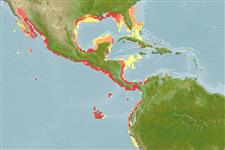>
Ophidiiformes (Cusk eels) >
Ophidiidae (Cusk-eels) > Ophidiinae
Etymology: Lepophidium: Latin, lepus, leporis = rabbit + Greek, ophis = serpent (Ref. 45335).
More on author: Gilbert.
Environment: milieu / climate zone / depth range / distribution range
Écologie
marin démersal; profondeur 6 - 250 m (Ref. 55763). Tropical; 32°N - 10°S, 116°W - 75°W (Ref. 91765)
Eastern Pacific: Gulf of California, Mexico to northern Peru (off Chiclayo) and along the outer coast of Baja California; offshore at Isla del Coco, Costa Rica, in the Islas Perlas, Panama, and Galapagos (record needs confirmation).
Taille / Poids / Âge
Maturity: Lm ? range ? - ? cm
Max length : 24.8 cm SL mâle / non sexé; (Ref. 91765)
Rayons mous dorsaux (Total) : 129 - 142; Rayons mous anaux: 109 - 121; Vertèbres: 70 - 75. This species is characterized by the following: usual number of vertebrae, precaudal 15 (14), caudal 57-58 (56-60), total 72-73 (70-75); fin rays, dorsal 128-133 (125-137), anal 108-111 (106-116) pectoral 22-23 (21-24); pyloric caeca 3-5, usually 3 in one tier, 1 in second, sometimes 4+1 or 2+1+1 (3 tiers); first gill arch with rudimentary rakers 3 (rarely 2) on the upper arm, 1-3 rudimentary rakers (0-4) anteriorly on lower limb; total rakers usually 9 (8-12); dorsal-fin origin between neural spines 3-4 (27 specimens) or 4-5 (9 specimens) (Ref. 91765).
Uncommon species (Ref. 34024) inhabiting sandy and muddy bottoms (Ref. 9329). Reproductive strategy possibly similar to other members of this family featuring oviparity, with oval pelagic eggs floating in a gelatinous mass (Ref. 205). Biology little known (Ref. 9329).
Life cycle and mating behavior
Maturities | Reproduction | Spawnings | Egg(s) | Fecundities | Larves
Robins, C.R., R.H. Robins and M.E. Brown, 2012. A revision of Lepophidium (Teleoastei, Ophidiidae), with descriptions of eight new species. Bulletin of the Florida Museum of Natural History 52(1):1-94. (Ref. 91765)
Statut dans la liste rouge de l'IUCN (Ref. 130435)
Menace pour l'homme
Harmless
Utilisations par l'homme
Outils
Articles particuliers
Télécharger en XML
Sources Internet
Estimates based on models
Preferred temperature (Ref.
123201): 14.8 - 26.3, mean 21.4 °C (based on 137 cells).
Phylogenetic diversity index (Ref.
82804): PD
50 = 0.5000 [Uniqueness, from 0.5 = low to 2.0 = high].
Bayesian length-weight: a=0.00219 (0.00121 - 0.00397), b=3.20 (3.04 - 3.36), in cm total length, based on LWR estimates for this species & Genus-body shape (Ref.
93245).
Niveau trophique (Ref.
69278): 3.6 ±0.7 se; based on size and trophs of closest relatives
Résilience (Ref.
120179): Haut, temps minimum de doublement de population inférieur à 15 mois (Preliminary K or Fecundity.).
Fishing Vulnerability (Ref.
59153): Low vulnerability (20 of 100).
